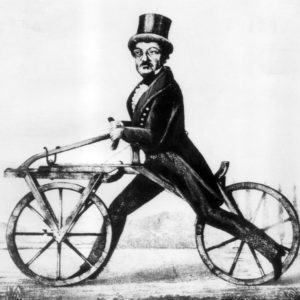
A two-wheel device built by Baron Karl von Drais. PHOTO: DPA/ZUMA PRESS
Good things can have disastrous beginnings. The humble bicycle, which marks its 200th anniversary this year, owes its birth to the gigantic eruption of Indonesia’s Mount Tambora in 1815. The debris launched into the atmosphere briefly cooled the globe and ruined harvests around the world.
One result was a shortage of feed for horses in Germany, where they were slaughtered in large numbers. In desperation over the loss of the animals, Baron Karl von Drais, a German aristocrat, began experimenting with the idea of human propulsion. Two years later he devised the first two-wheeled vehicle.
The baron’s device was a sort of steerable hobbyhorse on wheels that a rider pushed along with his feet. Drais called it a running machine, but the French soon renamed it the velocipede, from the Latin words for “swift” and “foot.”
Velocipedes become an international phenomenon, like roller blades two centuries later, but fell out of fashion just as quickly. It wasn’t until 1870, when James Starley invented the Penny Farthing, with its one giant wheel and another much smaller one, that people began to see the potential in bicycles. Still, as Mark Twain discovered every time that he encountered a pebble or rut, the Penny Farthing was only for the very fit or the foolhardy. He fell off so often that he quipped, “Get a bicycle. You will not regret it, if you live.” Continue reading…













 ‘If sack [wine] and sugar be a fault, God help the wicked,” says the rollicking Sir John Falstaff in Shakespeare’s “Henry IV, Part 1.” That was a more innocent time. Nowadays, books such as Gary Taubes’s “The Case Against Sugar” have linked it to many of the world’s health crises, including diabetes, obesity and high blood pressure.
‘If sack [wine] and sugar be a fault, God help the wicked,” says the rollicking Sir John Falstaff in Shakespeare’s “Henry IV, Part 1.” That was a more innocent time. Nowadays, books such as Gary Taubes’s “The Case Against Sugar” have linked it to many of the world’s health crises, including diabetes, obesity and high blood pressure. 